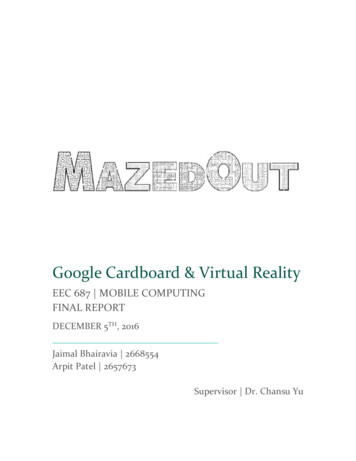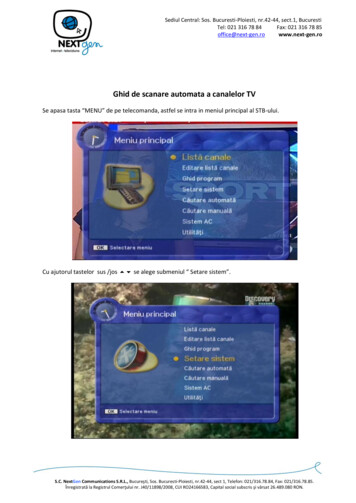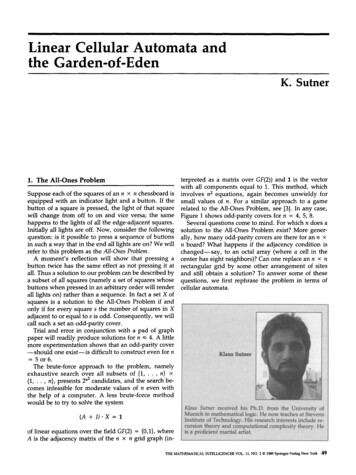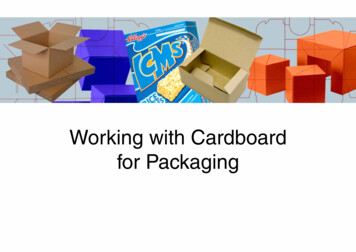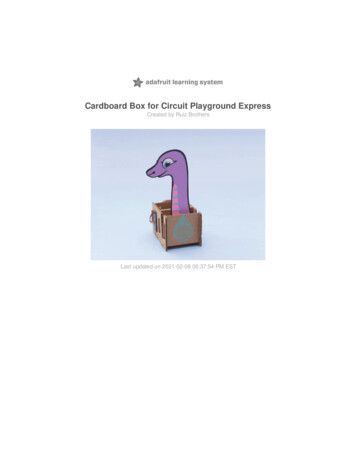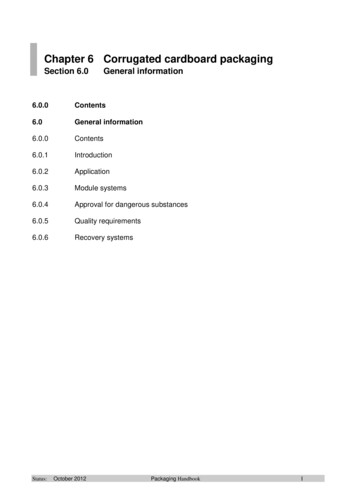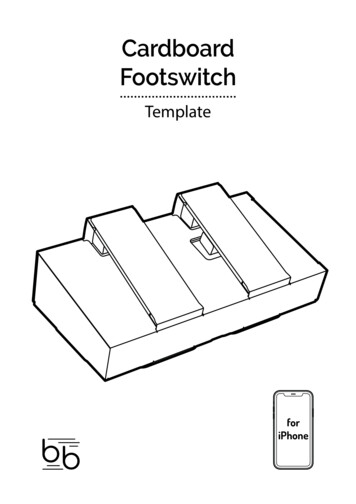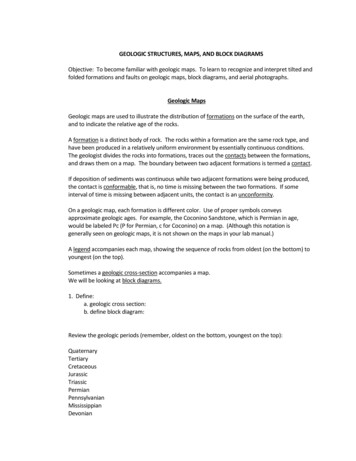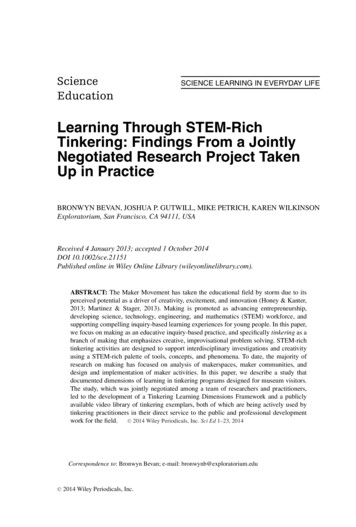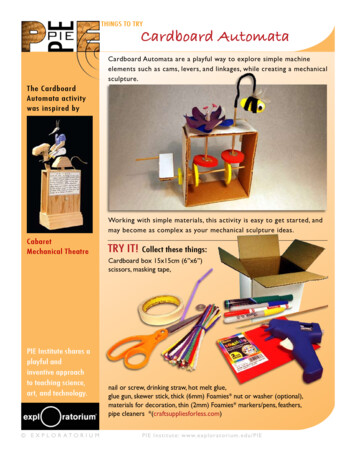
Transcription
THINGS TO TRYCardboard AutomataCardboard Automata are a playful way to explore simple machineelements such as cams, levers, and linkages, while creating a mechanicalsculpture.The CardboardAutomata activitywas inspired byWorking with simple materials, this activity is easy to get started, andmay become as complex as your mechanical sculpture ideas.CabaretMechanical TheatreTRY IT! Collect these things:Cardboard box 15x15cm (6”x6”)scissors, masking tape,PIE Institute shares aplayful andinventive approachto teaching science,art, and technology. E X P L O R ATO R I U Mnail or screw, drinking straw, hot melt glue,glue gun, skewer stick, thick (6mm) Foamies* nut or washer (optional),materials for decoration, thin (2mm) Foamies* markers/pens, feathers,pipe cleaners *(craftsuppliesforless.com)PIE Institute: www.exploratorium.edu/PIE
MAKE A FRAMECut the flaps off the box,then cut the box in two pieces(you get two frames from each box)Cut triangles out of theflaps and tape them into eachcorner of the frame for support.Things to Tr y: Cardboard AutomataPIE Institute: www.exploratorium.edu/PIEPage 2
Choose aMotionRound and RoundUp and Down,Round and RoundUp and Down,Back and ForthThings to Tr y: Cardboard AutomataPIE Institute: www.exploratorium.edu/PIEPage 3
MoreOptionsUp and DownSide to SideMAKE THE CAMSDraw your cam and cam follower on thethick Foamie sheet, and cut them out.The cam should be about 2.5” (6cm)in diameter.Tip: Cut the cams smoothly,and make sure the cam followeris a little bigger than the cam.Things to Tr y: Cardboard AutomataPIE Institute: www.exploratorium.edu/PIEPage 4
Make the AxlePut your cam on a skewerstick inside the frame.Tip: Start the holes in the frameusing a nail or screw, and makesure the cam clears the top andbottom of the frame.Make the HandleGlue a small rectanglecut from the cardboard box flapto the skewer stick axle.Glue a second piece of skewerstick to the end of the rectangleto make a handle.Add the Cam FollowerPoke a hole in the top of the frame where you want your cam follower to be located,and insert a drinking straw. Carefully glue the drinking straw in place.Tip: Use a pencil to make thehole large enough for thedrinking straw.Things to Tr y: Cardboard AutomataPIE Institute: www.exploratorium.edu/PIEPage 5
Glue your cam follower onthe end of a skewer stickand put it through the straw.Tip:The straw will keep theskewer stick from falling over.Test it!Adjust your cam under thecam follower until you get themotion you like, then GLUEthe cam into place on theskewer stick axle.Tip: If the cam follower doesnot fall on the cam,attach a washer or nut toadd a little weight.Tip: If your cam and axle moveout of place, add a smallbushing made from a scrap pieceof a thick Foamie.Tip: Make sure to glue the bushingto the axle and NOT to the frame.Things to Tr y: Cardboard AutomataPIE Institute: www.exploratorium.edu/PIEPage 6
DECORATE YOUR AUTOMATAThings to Tr y: Cardboard AutomataPIE Institute: www.exploratorium.edu/PIEPage 7
TAKING IT FURTHERYou can build automata out of avariety of everyday materials.MAKE YOUR AUTOMATACOIN OPERATED:Make a coin detector switchfrom three popsicle sticks,aluminum foil, masking tape,and a PicoCricket resistance sensor.www.picocricket.comProgram a PicoCricket to sendpower to a LEGO motor when itdetects a coin completing thecircuit in a coin detector.The skewer stick axle fitsnicely into a LEGO motor.Things to Tr y: Cardboard AutomataPIE Institute: www.exploratorium.edu/PIEPage 8
WHY IS THIS A PLAYFUL AND INVENTIVE EXPLORATION? A playful and inventive approach to learning simple machinesThis is a playful and inventive way of exploring levers, cams, cam followers, linkages, andother mechanisms. Science and art connectionsCardboard Automata are a good example of integrating science and art into an activity.For learners, the narrative, decorated aspects of the automata are as important as themechanical elements. Connections to other activities and the real worldThis activity is a good introduction to a variety of mechanisms and systems found in otherPIE activities, and in the real world.Things to Tr y: Cardboard AutomataPIE Institute: www.exploratorium.edu/PIEPage 9
RELATED IDEASPeter Markey is an artist who oftenmakes whimsical automata out of wood,utilizing cams and cam followers as hismain source of .co.uk/artists/markey/htmThe Cardboard Automata activity is a good introduction to another PIE activity called Sound Automata.Sound Automata introduce the idea of creating automata out of everyday objects in order to generate avariety of sounds and noises.Download theSound Automata Activity PDFfrom the PIE website.This material is based on work supported by the National Science Foundation under Grant No. ESI-04-52567.Any opinions. findings, and conclusions, or recommendations expressed in this material are those of the author(s)and do not necessarily reflect those of the National Science Foundation.Things to Tr y: Cardboard AutomataPIE Institute: www.exploratorium.edu/PIEPage 10
The Cardboard Automata activity was inspired by Cabaret Mechanical Theatre Cardboard Automata are a playful way to explore simple machine elements such a

